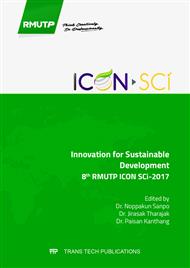[1]
M. McGranagham, and D. Mueller, Designing Harmonic Filters for Adjustable Speed Drives to Comply with IEEE- 519 Harmonic Limits, IEEE Transactions on Industry Applications, Vol. 5, Issue 2, pp.312-318, March/April (1999).
DOI: 10.1109/28.753622
Google Scholar
[2]
A. Hassanpour Isfahani, S. Vaez-Zadeh, Line start permanent magnet synchronous motors: Challenges and opportunities, Energy, vol. 34, no. 11, pp.1755-1763, Nov. (2009).
DOI: 10.1016/j.energy.2009.04.022
Google Scholar
[3]
Electromagnetic Compatibility (EMC)-Part 3: Limits-Section 6: Assessment of Emission Limits for Distorting Loads in MV and HV Power Systems, IEC 1000-3-6, (1996).
DOI: 10.3403/00967291u
Google Scholar
[4]
A. H. Isfahani, S. Vaez-Zadeh, S. Hasanzadeh, An educational toolbox for performance analysis of line-start permanent magnet synchronous motors, Comput. Appl. Eng. Educ., Aug. (2011).
DOI: 10.1002/cae.20569
Google Scholar
[5]
W. Xu, and Y. Liu, A Method for Determining Customer and Utility Harmonic Contributions at the PCC, IEEE Transactions on Power Delivery, Vol. 15, Issue 2, pp.804-811, April (2000).
DOI: 10.1109/61.853023
Google Scholar
[6]
D. M. Mathiasen, N. T. Olesen, C. W. Nielsen, S. T. Pedersen, Modelling and Implementation of a Line-Start Permanent Magnet Synchronous Motor in a Ventilation Test Set-up, no. 1m, pp.1-10.
Google Scholar
[7]
B. Palethorpe, M. Sumner, and D.W.P. Thomas, Power system impedance measurement using a power electronic converter, in Proceedings of IEEE International Conference on Harmonics and Quality of Power, 2000, Orlando, Florida. Vol. 1, pp.1035-1040, Oct (2000).
DOI: 10.1109/ichqp.2000.897026
Google Scholar
[8]
C. M. Ong, Dynamic Simulation of Electric Machinery: Using Matlab/Simulink, Prentice Hall PTR, (1998).
Google Scholar
[9]
J. Mazumdar, R. Harley, F. Lambert and G.K. Venayagamoorthy, Using a neural network to distinguish between the contributions to harmonic pollution of nonlinear loads and the rest of the power system, in Proceedings of the IEEE Power Electronics Specialist Conference (PESC 2005), Recife, Brazil, June 12-16, (2005).
DOI: 10.1109/pesc.2005.1581862
Google Scholar
[10]
M. Rahman, A. Osheiba, Performance of large line-start permanent magnet synchronous motors, Energy Conversion IEEE …, vol. 5, no. 1, pp.211-217, (1990).
DOI: 10.1109/60.50833
Google Scholar
[11]
B. Stumberger, M. Hadˇ, P. Virtiˇ, Determining Parameters of a Line-Start Interior Permanent Magnet Synchronous Motor Model by the Differential Evolution, vol. 44, no. 11, pp.4385-4388, (2008).
DOI: 10.1109/tmag.2008.2001530
Google Scholar
[12]
K.L.V. Iyer, Xiaomin Lu, K. Mukherjee, N.C. Kar, A Novel Two-Axis Theory-Based Approach Towards Parameter Determination of Line-Start Permanent Magnet Synchronous Machines, Magnetics IEEE Transactions on, vol. 48, no. 11, pp.4208-4211, Nov. (2012).
DOI: 10.1109/tmag.2012.2198208
Google Scholar


